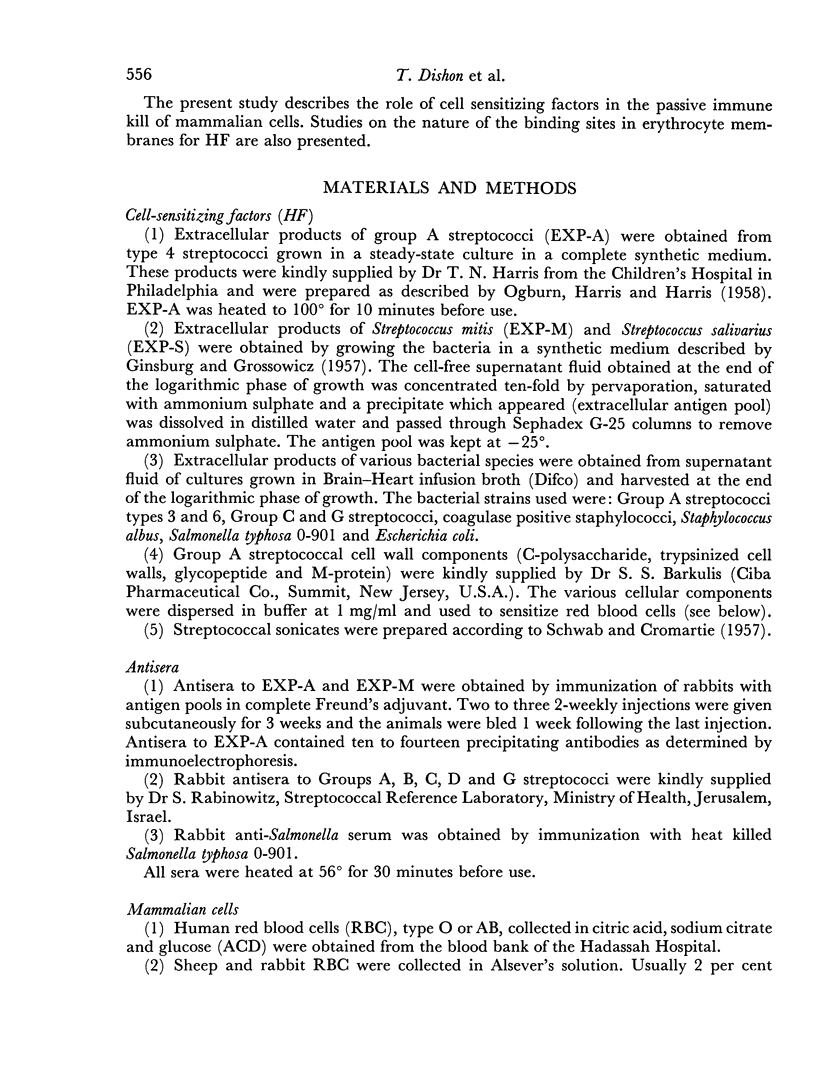Abstract
Various streptococcal species produce an haemosensitizing factor during the logarithmic phase of growth. A variety of mammalian cells sensitized with this factor become agglutinated following the addition of antistreptoccocal serum and also undergo cytopathic changes in the presence of complement. The haemosensitizing factor is thermostable and is unaltered by trypsin, papain, chymotrypsin, lipases or ribonucleases. Attempts to destroy the binding sites on the cell membrane by treatment with phospholipase C from Clostridium welchii or by neuraminidase failed. Treatment with trypsin or papain on the other hand markedly increased the binding capacity of red blood cell for the haemosensitizing factor.
Studies on the nature of the binding sites on the erythrocyte membrane of the haemosensitizing factor suggest that cholesterol and phospholipids constitute some of the binding sites for this factor.
Full text
PDF










Images in this article
Selected References
These references are in PubMed. This may not be the complete list of references from this article.
- BOYDEN S. V., GRABAR P. Rôle des lipides dans la sensibilisation des érythrocytes par les constituants de la tuberculine. Ann Inst Pasteur (Paris) 1954 Sep;87(3):257–267. [PubMed] [Google Scholar]
- Elias N., Heller M., Ginsburg I. Binding of streptolysin S to red blood cell ghosts and ghost lipids. Isr J Med Sci. 1966 May-Jun;2(3):302–309. [PubMed] [Google Scholar]
- GINSBURG I. Action of phospholipids on the cytotoxic effect of rabbit antibodies against Ehrilich ascites tumour cells. Br J Exp Pathol. 1960 Dec;41:648–659. [PMC free article] [PubMed] [Google Scholar]
- GINSBURG I., GROSSOWICZ N. Effect of streptococcal haemolysins on Ehrlich ascites tumour cells. J Pathol Bacteriol. 1960 Jul;80:111–119. [PubMed] [Google Scholar]
- GINSBURG I., GROSSOWICZ N. Group A hemolytic streptococci. I. A chemically defined medium for growth from small inocula. Proc Soc Exp Biol Med. 1957 Oct;96(1):108–112. doi: 10.3181/00379727-96-23406. [DOI] [PubMed] [Google Scholar]
- GINSBURG I., HARRIS T. N. OXYGEN-STABLE HEMOLYSINS OF GROUP A STREPTOCCI. IV. STUDIES ON THE MECHANISM OF LYSIS BY CELL-BOUND HEMOLYSIN OF RED BLOOD CELLS AND EHRLICH ASCITES TUMOR CELLS. J Exp Med. 1965 Apr 1;121:647–656. doi: 10.1084/jem.121.4.647. [DOI] [PMC free article] [PubMed] [Google Scholar]
- GINSBURG I., HARRIS T. N. OXYGEN-STABLE HEMOLYSINS OF GROUP A STREPTOCOCCI. II. CHROMATOGRAPHIC AND ELECTROPHORETIC STUDIES. J Exp Med. 1963 Dec 1;118:919–934. doi: 10.1084/jem.118.6.919. [DOI] [PMC free article] [PubMed] [Google Scholar]
- HARRIS T. N., HARRIS S. Agglutination by human sera of erythrocytes incubated with streptococcal culture concentrates. J Bacteriol. 1953 Aug;66(2):159–165. doi: 10.1128/jb.66.2.159-165.1953. [DOI] [PMC free article] [PubMed] [Google Scholar]
- Hamburger R. N., Mills S. E. Passive immune kill of cells in tissue culture. Immunology. 1965 May;8(5):454–460. [PMC free article] [PubMed] [Google Scholar]
- Jackson R. W., Moskowitz M. Nature of a red cell sensitizing substance from streptococci. J Bacteriol. 1966 Jun;91(6):2205–2209. doi: 10.1128/jb.91.6.2205-2209.1966. [DOI] [PMC free article] [PubMed] [Google Scholar]
- KRAUS F. W., KONNO J. Antibodies in saliva. Ann N Y Acad Sci. 1963 Mar 30;106:311–329. [PubMed] [Google Scholar]
- Marcus Z., Davies A. M., Ginsburg I. Oxygen-stable hemolysins of group A streptococci. V. Effect on rat heart and kidney cells grown in tissue culture. Exp Mol Pathol. 1966 Apr;5(2):93–107. doi: 10.1016/0014-4800(66)90007-4. [DOI] [PubMed] [Google Scholar]
- Moskowitz M. Separation and properties of a red cell sensitizing substance from streptococci. J Bacteriol. 1966 Jun;91(6):2200–2204. doi: 10.1128/jb.91.6.2200-2204.1966. [DOI] [PMC free article] [PubMed] [Google Scholar]
- NETER E. Bacterial hemagglutination and hemolysis. Bacteriol Rev. 1956 Sep;20(3):166–188. doi: 10.1128/br.20.3.166-188.1956. [DOI] [PMC free article] [PubMed] [Google Scholar]
- NETER E., ZALEWSKI N. J., ZAK D. A. Inhibition by lecithin and cholesterol of bacterial (Escherichia coli) hemagglutination and hemolysis. J Immunol. 1953 Sep;71(3):145–151. [PubMed] [Google Scholar]
- OGBURN C. A., HARRIS T. N., HARRIS S. Extracellular antigens in steady-state cultures of the hemolytic Streptococcus: production of proteinase at low pH. J Bacteriol. 1958 Aug;76(2):142–151. doi: 10.1128/jb.76.2.142-151.1958. [DOI] [PMC free article] [PubMed] [Google Scholar]
- PAKULA R., WALCZAK W. An erythrocyte-sensitising factor common to staphylococci and haemolytic streptococci. Acta Microbiol Pol. 1955;4(4):235–243. [PubMed] [Google Scholar]
- RANTZ L. A., RANDALL E., ZUCKERMAN A. Hemolysis and hemagglutination by normal and immune serums of erythrocytes treated with a nonspecies specific bacterial substance. J Infect Dis. 1956 Mar-Apr;98(2):211–222. doi: 10.1093/infdis/98.2.211. [DOI] [PubMed] [Google Scholar]
- SCHWAB J. H., CROMARTIE W. J. Studies on a toxic cellular component of group A streptococci. J Bacteriol. 1957 Nov;74(5):673–679. doi: 10.1128/jb.74.5.673-679.1957. [DOI] [PMC free article] [PubMed] [Google Scholar]
- STEWART F. S., MARTIN W. T. Adsorption of a streptococcal red cell-sensitising antigen to various tissues. J Pathol Bacteriol. 1962 Jul;84:251–253. doi: 10.1002/path.1700840135. [DOI] [PubMed] [Google Scholar]
- STEWART F. S., STEELE T. W., MARTIN W. T. The mechanisms involved in the production of red cell panagglutinability by streptococcal cultures. Immunology. 1959 Oct;2:285–294. [PMC free article] [PubMed] [Google Scholar]
- TAN E. M., KAPLAN M. H. Renal tubular lesions in mice produced by streptococci in intraperitoneal diffusion chambers. Role of streptolysin S. J Infect Dis. 1962 Jan-Feb;110:55–62. doi: 10.1093/infdis/110.1.55. [DOI] [PubMed] [Google Scholar]



